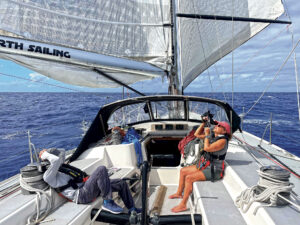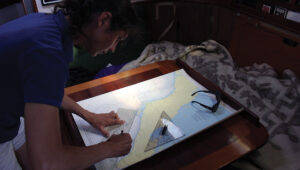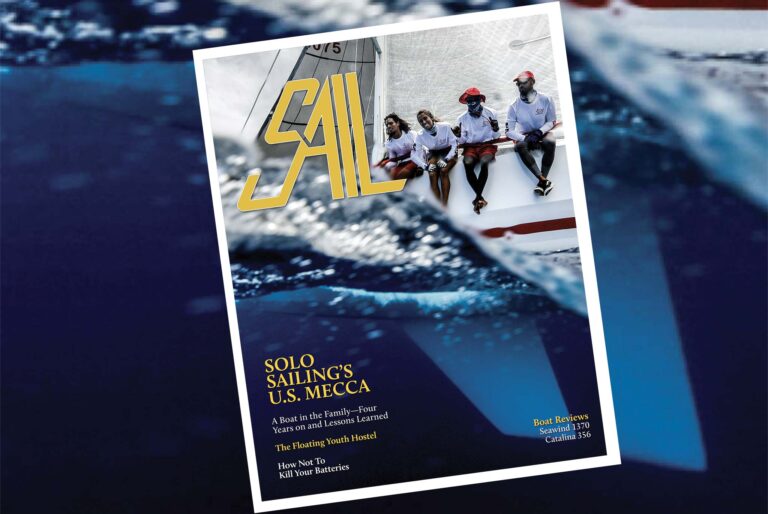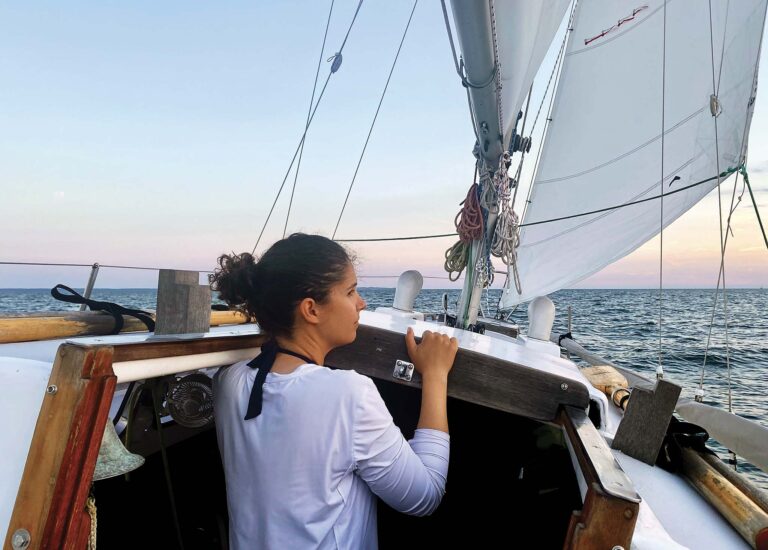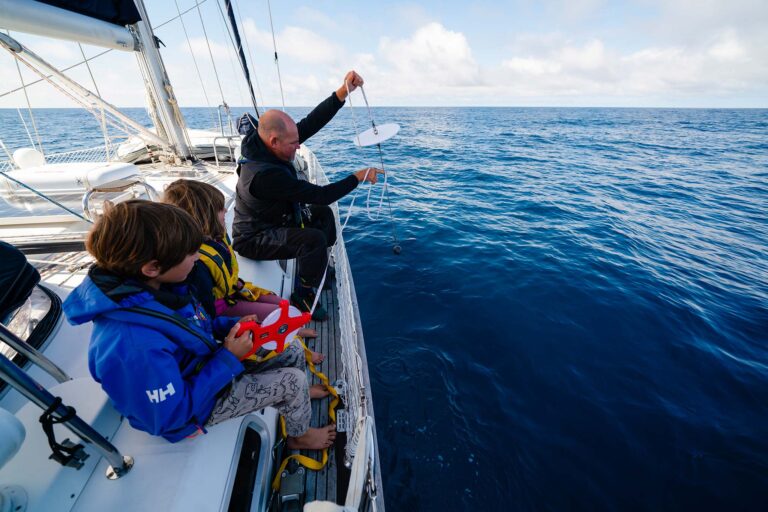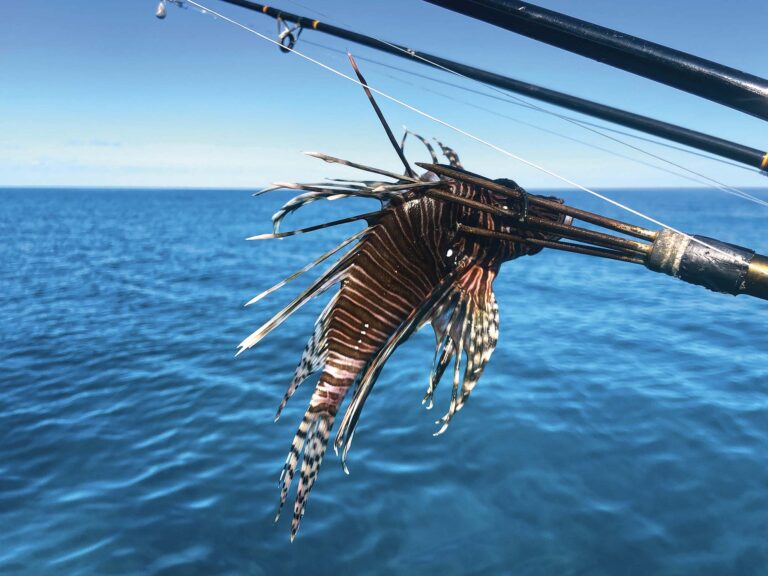
After a season of club racing, the Skipper (aka Kevin McHugh) and I were on the hunt for a faster boat—who isn’t? The Hudson at Kingston, New York, is a tricky spot to race: sheltered by hills on each side, it is narrow, fluky and tideswept. Watching the winners from the back of the pack, we noticed the 1970s designs with radically swept-back keels had an advantage clawing against the current in light air. We scoured online ads and the local boatyards for 50 miles around. Then the Skipper’s sharp eye landed on a “free” sign posted way back in a boneyard of old craft tucked away at the far end of our very own marina.
It was a Pearson 26, a notorious PHRF-beater sporting just the keel-shape we wanted, although other than that it was a sad sight with little to recommend it. Due to the owner’s health it had been sitting ashore for 12 years—right under a tree giving shade for moss to grow and easy access to Rondout Creek’s river rats.

Worse still, the hull had been on jackstands the whole time, as opposed to a cradle, and the stands weren’t well placed, so that those at the stern had pushed right up against the cockpit lazarette’s thin hull, rather than against a bulkhead. Dents! Maybe this could work anyway, I thought. Let’s call it an “IOR bustle.”
Quick action by the Skipper secured ownership of Willow for our team. New York State registration in hand, our first step was to move her out from under the tree to a spot with water and electric hookups. Inspection revealed an unexpected surprise. A Good Samaritan, concrned that the untended hull was collecting rainwater, had drilled a 2in hole in the bilge: a good thing since both cockpit drain hoses had long since deteriorated, so that rain falling in the cockpit had been going into the bilge instead of through the seacocks. A “bathtub ring” in the cabin told the tale. Unfortunately, since the hole was drilled from outside, its placement was unlucky—right underneath a hull crossbrace—so there was no access from inside to make a repair.
Of course, every piece of rope on Willow was moldy. When we touched the tiller it also cracked right off at the screw holes, and the hatchboard plywood was peeling apart. At least the river rats had been happy: paper towels from the galley and sailcloth chewed from the center of both the main and jib had made for a true “Ritz for Rats.” Finally, the speed and depth displays left uncovered in the sun, were toast. The good news was that a newer set of sails (including a brand-new asym spinnaker) had been stored off the boat, and there was a magnetic compass still in its carton, not yet installed.

As we surveyed the wreck before us I suggested that we paint Willow black and rename her Rat Rod, but the Skipper wouldn’t go for it. He refuses to be seen driving anything less than Bristol fashion and immediately set to work with a powerwasher and boat soap—a hopeless case, I figured.
Still, they say the best bilge pump is a worried sailor with a bucket, and maybe the best boat cleaner is a determined skipper with a powerwasher. After a week’s perseverance, the impossible seemed to have resulted: a spotless hull with only the teak trim worse for wear (having not taken kindly to high-pressure massaging).
After that, with cold weather settling in, we made plans for the rest of the refit. Clearly, new instruments were needed, along with a VHF radio and masthead antenna, anchor light, running rigging, tiller and some dent repair. We also had to seal that hole in the bilge.
As we set to work, the dockmaster, Vince, donated a tiller from his stash of supplies, and the Skipper loaded a sandbag into the lazarette over each dent. After some thought, a bronze plug with an external flange seemed the most secure fix for the “Good Samaritan” bilge hole.
Alas, come springtime, those hull dents were hardly any smaller. Clearly, it was going to take more persuasion than just a few sandbags, and with race season approaching a fix was due soon. We, therefore, propped a 2×4 against a plywood plate placed over the portside dent with the other end sticking up into the cockpit from out of the lazerette. Running a dockline over the projecting end of the 2×4, we then used the cockpit winches to draw it taut, forcing the 2×4 against the dent. Leaving a portable heater running inside the lazarette, we departed for the day with fingers crossed.
Luck was with us again. After a day’s treatment on each dent, they were hardly noticeable. To make sure they didn’t come back, we also reinforced the inside with a strip of waterproof cellular-PVC.
Finally, the big day came—launching, and the question as to whether the boat would actually float. Never having done this kind of hull repair before, we didn’t entirely trust our work, prompting the Skipper to decide our newly restored racing craft needed a more ominous name than Willow, hence her re-christening as Omen. I don’t think the Skipper slept easy that night, but our luck held yet again, and Omen was still floating the next day. In fact, there was not a drop of water in the bilge.
Ultimately, the biggest expense of our refit was a new #1 genoa. Since the #1 on a P26’s sailplan is larger than the spin, we also opted to spring for a light-air triradial that could work both upwind and down (on a whisker pole).
When we hit the racecourse for the annual Maritime Cup regatta held at the Kingston Sailing Club, the payoff for our winter’s refit work was sweet: first place in the non-spin division, with three bullets in three races.
Takeaway Tips
• Don’t let the mere appearance of an old boat scare you off. Perseverance with the powerwasher works wonders; but mask the teak first.
• Take care when placing jackstands for winter storage. Locate the bulkheads and put stands on them, not on an unsupported section of hull.
• Yes, there really might be a boat Santa Claus—if you keep a sharp eye on the marina’s boneyard.
Photos by Ron Kronstadt
November 2018

